
 |
|
 |
| Northern Edge 2008 |
| Latest update: December 2008 |
| Northern Edge: War in Alaska |
| Northern Edge (NE) is one of two major exercises held in the state of Alaska and run by Pacific Command (PACOM) / Pacific Air Forces Command (PACAF) or US Northern Command (USNORTHCOM). PACOM organized the NE exercised during even fiscal years and USNORTHCOM the odd fiscal years. However due to a realignment NE08 and NE09 are conducted by PACOM and from NE10 all even fiscal years by NORTHCOM. The later will also focus on homeland defense and homeland security and is therefore combined with the State of Alaska exercise Alaskan Shield. The exercise will be executed as AK-NE. The other exercise is Red Flag Alaska (RF-A). RF-A is held three times a year, Northern Edge annually for a period of two weeks. NE’s history dates back to 1975. The name of the exercise then was Jack Frost and was held bi-annually. From 1981 till 1989 it was renamed Brim Frost which turned into Artic Warrior in 1991. From 1993 the exercise received its current name and became an annual held exercise again. Alaskan Command (ALCOM) which is part of PACOM was sponsor for the Jack Frost exercise and currently is responsible for the execution of NE. The Brim Frost exercises were run by US Readiness Command. The main goal of NE is the integration of all services by practice operations, techniques, procedures and to improve C3 (Command, Control & Communication) between the different services. Both NE and RF-A are flown from Elmendorf and Eielson Air Force Bases while NE also sees the participation from the US Army operating out of Ft. Wainwright and/or Ft. Richardson and the US Navy deploying a carrier battle group (CBG) to the Gulf of Alaska. |
| Northern Edge 2008 |
| As already said Alaska is home to two exercises.
Due to the environmental circumstances the exercises are held between
April and October. There are two major differences between Northern Edge
and Red Flag Alaska: Northern Edge is a US only exercise with participation of all branches of the department of defense (Air Force, Navy, Marines, Army and Coast Guard). The participating forces are drawn from the PACOM area of operations. The main focus is on the integration of all services. Red Flag Alaska: USAF exercise drawing participants from all USAF units including Air National Guard (ANG) and Air Force Reserve Command (AFRC). Participants can include other DoD services and often allied (NATO) or friendly forces are taking part in the exercise. One RFA sees the participation of the Japanese Air Self Defence Force who will deploy usually six of its F-15 Eagles. The main focus is on aerial combat. The scenario of NE08 was classified and no comments were made regarding this subject. The US Army conducted their operations on the range nearby Ft. Wainwright which is located just outside the city of Fairbanks 360 miles (579 km) north of Anchorage. USAr infantry was supported by Ft. Wainwright based UH-60 Blackhawk. US Marine land assets also deployed to this region and included Marine reconnaissance units. The USMC forces were supported in the air by a squadron of F/A-18D Hornets which in turn were supported by two KC-130 Hercules tankers. As already said the CBG didn’t participate but would have been tasked with maritime, land and air strikes. Two US Navy destroyers deployed to the Gulf of Alaska conducted operations but also served as targets for other participants. The air war is fought over the PARC and the Gulf of Alaska. Where as Red Flags (both Alaska and Nellis AFB) are designed to train the junior aircrews to survive the first ten war sorties NE focuses on the senior aircrews. Being able to conduct a NE mission means the pilot has to be qualified to be a wingman in order to plan and execute a mission involving different assets (OCA, DCA, SEAD, CAS etc). NE exercises are by no means meant as an upgrade exercise for the aircrews. |
| NE planning and Live Virtual Constructive |
| Major Collins who is running the NE exercise
explains the planning process and the use of the L-V-C- which was fully
implemented in NE08. ‘The planning process for a Northern Edge exercise starts 13 months out. There are four different conferences: concept development conference, initial planning conference, mid planning conference and then the final planning conference. In each step of the way we start from big to small. We come up with our initial ideas where we want to go with the exercise and then underneath we start to identify training objectives. Then we get these objectives down to the unit, into the tactical level, were guys have the opportunity to practice together. The training that they do for Red Flag Alaska and Nellis for the blue force is mainly done to train new aircrews so they learn to survive the first 10 combat missions. This exercise is more directed at what we call Blue one, the leadership of the fighting forces so they can operate at a higher level and do more of the force positioning and practice the command and control expects of the exercise. Northern Edge is designed to support the forces for PACOM. We try to the maximum extend possible to draw the forces underneath the PACOM structure. So we put a list together and see who’s available based on operational commitments and then requirements and then we design our force list based on the availability and what we can afford.’ One part on the exercise involves the use of live-virtual-constructive (L-V-C). The major explains L-V-C. ‘What we are able to do through L-V-C is virtual which means actual people in simulators are flying aircraft simulators in ten time zones, from Georgia all the way down to Japan. There’s also some local participation. We can get to the high demand, low density aircraft like the E-8 JSTAR. An E-2 Hawkeye is participating as well as a submarine participant. With L-V-C simulation we can put those forces side-by-side with the live forces and show a more complete picture of the operation. So we can get some good learning with virtual constructive, using the same rule set for the live participants as far as the way we operate and get practice in the simulator. We get a more robust exercise from that overall perspective. The 18 WG based at Kadena air base Japan participates with the F-15, they have the same picture as the live players. On the cockpit display they can see the complete picture through the use of LINK16 and the pictures presented by the E-2 and E-3 although they only operate in their own lane. We have safety that L-V-C doesn’t fly in the live by the use of geographic de-confliction. We also used LV in NE06 but it was more used as a demonstration. What our overall goal is to make it a relevant piece of the exercise. Sometimes if you go to the simulator maybe you are a training aid, but in this case we are making valuable training to the people that are doing the simulators by integrating them into the actual live war and that’s what is a little bit different as well as this time we were able to get a more of a joint flavor as far as having the Marine Hornets who are participating out of Saint Louis. We have the E-2 simulator out California and the sub operating out of Hawaii.’ Can you call L-V-C a success? ‘It is. The briefings that you will see from the live are replicated and matched in the virtual so it’s very hard to distinguish the difference between the quality of the brief that you will get in the virtual and the quality that you get in the live, so training simultaneously, parallel and thought and process is just the system. We can’t replace the fog and friction of the war in a live aircraft and let’s say the challenges of a tanker not being available. In the virtual it’s a clean environment as far as your plane is always going to work in the virtual so you don’t have to worry about it breaking, that’s one of the major differences. There’s trade offs, good and bad.’ What will be the future? Virtual will be cheaper because squadrons don’t have to deploy all the way down from Japan for instance. ‘I think L-V-C will be an aid to help maybe inexperienced people get a flavor of what they are going to actually do live in the cockpit so maybe training would maybe be more focused on inexperienced people, they do some simulators and once there are very proficient at simulators they will be even better in the live. I don’t think we will replace one for the other because each has its strength and limitation and the live participation is very valuable for all the reason that I said, the fog and friction. Why is there a geographical separation between the live and virtual? ‘One instance that is new to NE08 as far as replicating some surface contacts, things that you won’t hit airborne. You don’t want to fly into something or be confused as there’s a potential air contact. We have some ground simulations that are instrumented that a virtual platform, in this case an E-8, will talk through digital to live communications from the simulator to the live E-3 which will target a live aircraft to a simulated ground target. You can see a complete picture in either the simulator or the live cockpit based on the one situation display and that display is also part of the common operational picture that goes to our headquarters. So at the HQ level they will see the live and virtual. It will be dots for them but the will see both, the robust war, which is a challenge for the HQ as well as the C2 platforms and all the way down to the tactical cockpit. How many aircraft are playing in the virtual world, for the real fighting about 120 aircraft are available? ‘We scripted to match the force ratio, so if we have 16 live blue fighters in the real we will match in the virtual lane 16 blue fighters. We may have 16 actual people in cockpits in the virtual but then the rest we will have computer constructed aircraft, but the force ratios are matched . In the virtual we can create a more robust OPFOR (editor: opposing forces also known as Red Air). We can only simulate so many OPFOR for live but in the virtual we are only limited by the amount of computer bytes you want to program. |
| 353 Combat Training Squadron |
| The 353 CTS is based at
Eielson AFB and maintains a detachment (353 CTS det.) at Elmendorf AFB
to support the Northern Edge exercise. Its mission is to conduct the Red
Flag Alaska exercises. The 353 CTS det. consists of about 30 people.
Major Toogood is an F-15C Eagle pilot detached to the 19 FS but
currently assigned to 353 CTS and runs the NE exercise. ‘NE is different
from RF-A because it’s a PACOM exercise and there delegation of exercise
administration goes down to ALCOM. Because ALCOM has a lot of work to
do, they have a shop of 6 people (1 military and 5 civilian) to support
the exercise of this scale. Because of the lack of manpower and
facilities the 353 CTS helps out with the organization of NE. RFA is run
under the direction of 353 CTS.’ During NE Maj. Newton the 3rd Wing
weapons tactician was assigned to the white force to support the
participant with his expertise. The major was an F-15C pilot and joined
the initial F-22A Raptor cadre at Edwards AFB. After being assigned to
the Pentagon he was assigned to 3 Wing and currently flies the Raptor
with the 90 FS. Because 3rd Wing operates both the F-15 Eagle and the
F-22A Raptor the knowledge gained of flying both aircraft within one
wing was used with Northern Edge. Why is NE a strictly US forces exercise? Mr. Brian Lepley (US Army PA officer) answers. ‘It’s a PACOM exercise so the training needs are for PACOM.’ It’s a change for PACOM forces to train for various missions.’ What’s the difference between RFA and NE? ‘The focus for RF is for tactical air combat and some of that kind of spills over to CAS for Army units but usual not. Typical RF scenario’s goes out of striking targets and getting out. Sometimes it’s possible to support the Army in their request. For NE08 the Army plays a minor role compared to previous years because of the operational commitments of the Alaska based aviation and infantry brigades.’ In the past the USAF only had one aggressor squadron (414 CTS), now PACAF activated the 18 AS with F-16s and ACC has the 65 AGRS with F-15s. How do these forces integrate? “They integrate together. A couple of years ago we didn’t have aggressors here in Alaska. The 18 FS changed mission to the 18 AS. Because NE is such a large scale exercise we also asked the 65 AGRS with their F-15 Eagle to participate and also the NSAWC F/A-18s from Fallon NAS are helping out. We just wanted to bring a very robust adversary package to the exercise. All three of the units work together very well. They normally choose a day were the 18 AS will lead the way, they will plan it and they will dictate everyone’s participation for that mission. What can you tell about the participation of the 422 TES ‘OT’ F-15s, are they playing on the blue or red side? ‘Actually they are supplementing both sides. They are always in operation test so software development etc. It gives them an opportunity to integrate with the F-22 and F-15s and the other forces. How do compare the range complex compared to Nellis? ‘It’s a very unique environment here. If you look at the airspace it’s much larger then at Nellis. We can spread out and not limit our scenarios’ due to airspace constraints. We can set up any type of scenario. However on the flip side we have a lot less range space. I mean impact area’s for ordnance. So we have a lot less flexibility to conduct live weapons delivery. So that’s one of the advantages of Nellis. Also because of their greater range space they have more simulated air threats. We do have about 1.400 targets but it’s not even close to what Nellis has.’ Mr. Lepley adds: ‘we also have the Gulf of Alaska to conduct the land/sea operations.’ Can you tell us how the F-15/F-22 work tactics wise? ‘We are still learning a lot but the F-22 defiantly brings a lot to the fight. It integrates in a very unique way. An F-15, F-16 or F/A-18 fighting side-by-side are very similar in the tactics and where they position themselves, but when you put the capabilities of the F-22 and its stealth it changes where its needs to be in the fight. It really does complement and we experiment how to best maximize everyone’s capability in that fight.’ Is that what happens in this exercise integrate the F-22 into the exercise? Yes it is, its one of the main focuses to figure out how to integrate that weapon system with the rest of the weapon system. What is the training value for other aircraft because of the F-22 capabilities? ‘We thought the same thing. That if we have this asset which is so capable and does everyone else’s job what will everyone else get out of the exercise. What we found is by adjusting the threat in numbers and capabilities and reducing the offensive numbers and capabilities we are actually capable of striking a good balance where there is still a lot of training. We adjust the scenario so everyone gets good integrated training. We can easily put equal number of F-22s against to an equal number of opposing forces and let them do the fight but then there’s really nothing left for anybody else. So that’s one of the reasons why we wanted a robust threat here and we limit the amount of Raptors flying around to strike a balance for the integration.’ What are the scenario rules for both Blue and Opfor forces? Are they allowed to re-enter the fight after being shot? ‘We supplement Opfor with blue forces so we have more then 16 aircraft available. If a red air aircraft is killed during the fight he will go to a point and regenerate and continue the fight. That’s all coordinated through the red air game plane. On the blue side the way we are handling that is if you're killed you go home. It makes it a little more realistic and it helps us to with our training because we have to deal with one aircraft less. How has Northern Edge 2008 gone? ‘It has been an excellent exercise, we’ve done a lot of things for the first time in this exercise. I think a lot of leaning has happened. All I can say is that things taken from this exercise will have an impact on our forces and let us make the right improvements. What will you do with the lessons learned, are you going to take them into Red Flag exercises? ‘Yes we will. What you probably going to see the most is that the experts flying here will refine the tactics and techniques and they will help it incorporate it into our written guidance that will permeate through the enter department of defence. Through Red Flags it will be passed on to other nations.’ The author wishes to thank the following people for their assistance during and after the visit: Public Affairs ALCOM, 3 Wing and 354 Wing in particular Maj. A. Herritage, Capt. C. Miller, MSgt. Krause, Mr. B. Lepley, TSgt Canfield and Tsgt Gott. ALCOM Maj. J. Collins. 3 Wing Maj. Newton and 353 CTS Maj. D. Toogood. |
| Participants Northern Edge 2008 |
|
| Comment(s): |
| Photo gallery Air-to-Air |
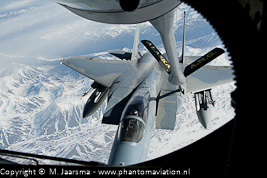 |
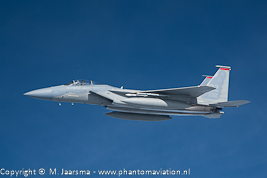 |
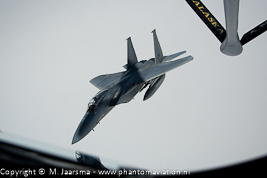 |
| An 19 FS F-15C being refueled over the Alaska range. | F-15s from 18 Wing also joined up to be refueled by a 168th ARS KC-135R. | An 18 Wing F-15C breaks away from the tanker after being topped up. |
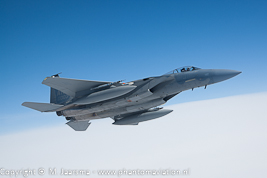 |
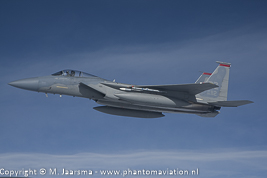 |
|
| F-15C Eagle from 19th FS waiting for his turn be refueled. | 67th FS F-15C in formation with the KC-135R waiting for his wingman. |
| Photo gallery Eielson AFB |
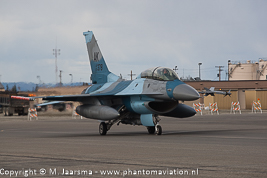 |
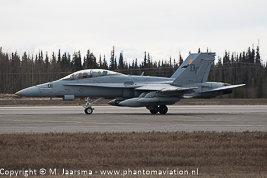 |
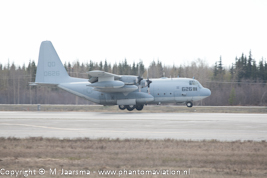 |
| 18th AGRS F-16D. |
VMFA(AW)-242 F/A-18D taxiing to the runway. | A VMGR-152 KC-130R returns after completing a Northern Edge sortie. |
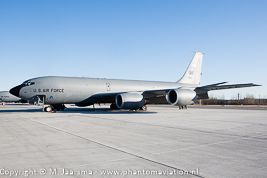 |
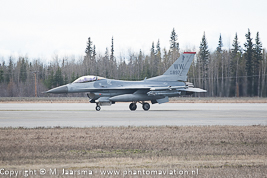 |
|
| 168th ARS Alaska ANG KC-135R on the ramp of its homebase | A F-16C assigned to 13 FS / 35 FW operating from Eielson AFB. | |
| Photo gallery Elmendorf AFB |
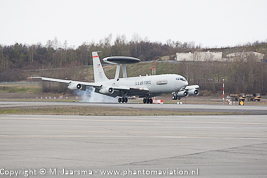 |
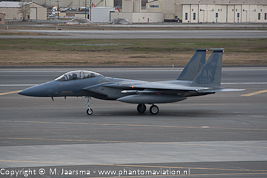 |
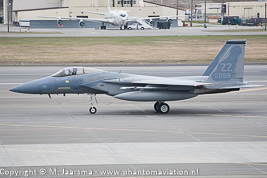 |
| 961st AACS E-3B AWACS returning at Elmendorf AFB. | 19th FS F-15D Eagle taxiing towards the runway. | 18th Wing brought F-15s of both 44th FS (photo) and 67th FS. |
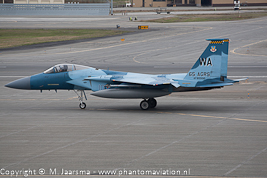 |
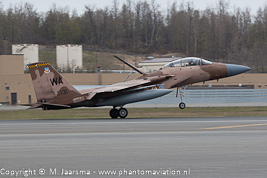 |
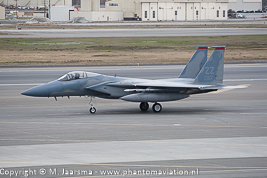 |
| 65th AGRS brought its colorful blue and |
brown F-15s. |
67th FS Eagle about to depart for its next mission. |
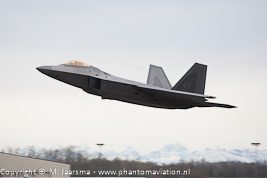 |
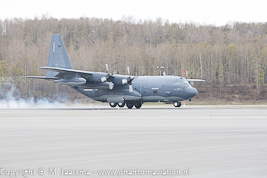 |
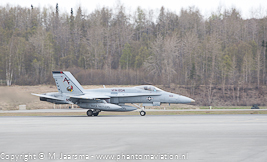 |
| 90th and 525th FS (and associate AFRC 302nd FS) took part with their F-22A Raptor. | HC-130H from the 176th AW at nearby Kulis ANGB
arriving at Elmendorf AFB. |
US Navy reserve VFA-204 F/A-18A+. |
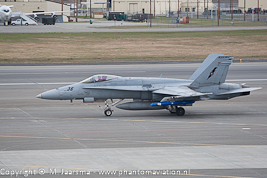 |
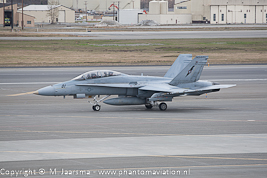 |
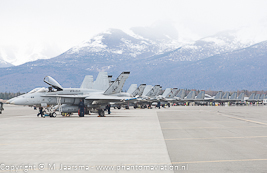 |
| The NSAWC (Naval Strike and Air Warfare Center) participated with its F/A-18C | and F/A-18D Hornets. |
VFA-204 Hornets on the flight line with 18 Wing
Eagles next to them. |
|
|